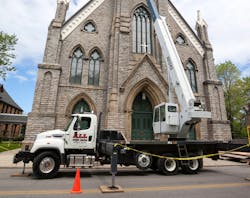All Crane Launches Shared Equipment Program to Cut Jobsite Costs
The All Family of Companies has announced its Shared Equipment Program, enabling contractors to re-rent All’s equipment to other contractors or subcontractors. The way it is designed to work is that a project’s general contractor would act as the primary renter of all the lifting equipment required for a job, and then would rent it to subcontractors.
According to All Crane, the SEP program helps eliminate waste, cuts costs, and improves productivity. More than just the equipment, the project gets support from the All team, including mechanics who conduct regular maintenance to keep machines in “rent-ready” conditions as they change hands between subcontractors.
All says the SEP program can eliminate redundancy and waste, which can be as much as one-third of the total project cost. All adds that equipment redundancy does more than add costs – it also adds a level of congestion to jobsites where space is at a premium, which can affect everything from traffic to safety. All says the SEP addresses all these concerns and that All works with the general contractor to maximize efficient usage of lifting equipment.
All developed the program to reinforce its unique blend of resources afforded general contractors, including a broad continental footprint, and an extensive and varied fleet. The program works best when all subcontractors have ready access to equipment that meets their needs, from steelworkers who may require hefty all-terrain equipment to painting and electrical contractors whose finishing work requires access equipment like scissor lifts. All’s equipment lineup includes crane types as small and versatile as mini/spider cranes or as large as 900-ton ATs and 1,000-ton crawlers, plus tower cranes, boom lifts/aerials/MEWPs, and boom trucks.
Beyond these extensive equipment resources, the company has the experience and willingness to collaborate both initially and then ongoing, which help make the equipment-sharing process successful. All said it has already executed projects using SEP, saving project owners tens of millions of dollars and helping to complete projects months ahead of schedule.
SEP differs from a sole supplier agreement in that under SEP, All would be the only supplier of lift equipment to the project, but only the general contractor rents the equipment from All, then coordinates distribution to subcontractors. In a typical sole supplier arrangement, All said, individual subcontractors are still responsible for procuring their equipment (using the same supplier), but must negotiate their own supply. The added benefit of SEP is that, with a single renter (the general contractor) acting as a single point of contact for subcontractors to access equipment, additional efficiencies are created, saving time and money.
About the Author
Michael Roth
Editor
Michael Roth has covered the equipment rental industry full time for RER since 1989 and has served as the magazine’s editor in chief since 1994. He has nearly 30 years experience as a professional journalist. Roth has visited hundreds of rental centers and industry manufacturers, written hundreds of feature stories for RER and thousands of news stories for the magazine and its electronic newsletter RER Reports. Roth has interviewed leading executives for most of the industry’s largest rental companies and manufacturers as well as hundreds of smaller independent companies. He has visited with and reported on rental companies and manufacturers in Europe, Central America and Asia as well as Mexico, Canada and the United States. Roth was co-founder of RER Reports, the industry’s first weekly newsletter, which began as a fax newsletter in 1996, and later became an online newsletter. Roth has spoken at conventions sponsored by the American Rental Association, Associated Equipment Distributors, California Rental Association and other industry events and has spoken before industry groups in several countries. He lives and works in Los Angeles when he’s not traveling to cover industry events.
